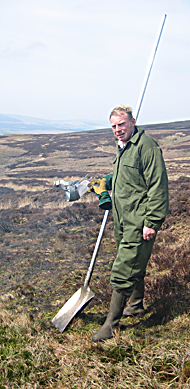
| HOME |
| PROJECT DETAILS |
| PROJECT ADMINSTRATION |
| PUBLICATIONS |
| JOINT RAPTOR STUDY |
| THE MOOR |
| THE GROUSE |
| THE RAPTORS |
| OTHER WILDLIFE |
| DIVERSIONARY FEEDING |
| GAMEKEEPING |
| WILDLIFE SURVEYS |
| NEWS |
| CONTACT |
| PHOTO GALLERY |
| GAMEKEEPING |
Staff A team of gamekeepers are employed to do the moor management at Langholm which will include heather burning, bracken control as well as legal predator control under the terms of the Scottish Natural Heriatge's Open General Licence. The gamekeeping team is led by Simon Lester, formerly Headkeeper at Holkham Estate in North Norfolk where he restored and developed a very successful shoot based on wild grey partridges. One of the underkeepers was formerly employed at Langholm in the 1990s and two others were beat keepers as part of the Game & Wildlife Conservation Trust's predation experiment on the Otterburn ranges in Northumberland. Predator Control Predator control is aimed pricipally at foxes, stoats and carrion crows which are the main predators of grouse. Although this control undertaken year-round it is especially important in the spring and early summer when grouse are nesting and their eggs and chicks most vulnerable. Control involves shooting and trapping. Crows are mostly caught in cage-traps; stoats mostly with underground tunnel traps, and foxes are either snared or shot with a rifle. The project has adopted the most advanced snares available in order to minimise any welfare impacts. The project's Scientific and Technical Advisory Group keeps all he methods used by the gamekeeping team under review. Habitat Management Heather burning (muirburn) takes place in order to produce a patchwork of different aged stands that suit the food and cover requirements of the grouse. The dry heath sections of the moor are being burnt on a fifteen year cycle, and some of the blanket bog sections are burnt on a much longer rotation - if at all. Heather burning takes place in the winter months when weather conditions permit. Grazing by sheep and goats is managed 'in-hand' by the Estate. Damage cuased by heather beetles has been a significant issue for the moor for many years. Historical grazing pressure and heather beetle damage has led to a loss of heather from parts of the moorand replacement with Purple Moor Grass (Molinia caerulea) dominated moor. Novel management This grass habitat has low biodiversity and food value so the Project has invested heavily in spraying, cutting and burning of this habitat. By late summer 2011 260ha of this grass habitat has been sprayed to kill the Molinia. Weather permitting, this habitat will be burnt in September under licence from Scottish Natural Heritage. This will stimulate regeneration of heath and berry species and non-invasive grasses. This will be the first time such burning has legally been possible in Scotland since the 1940s. |
